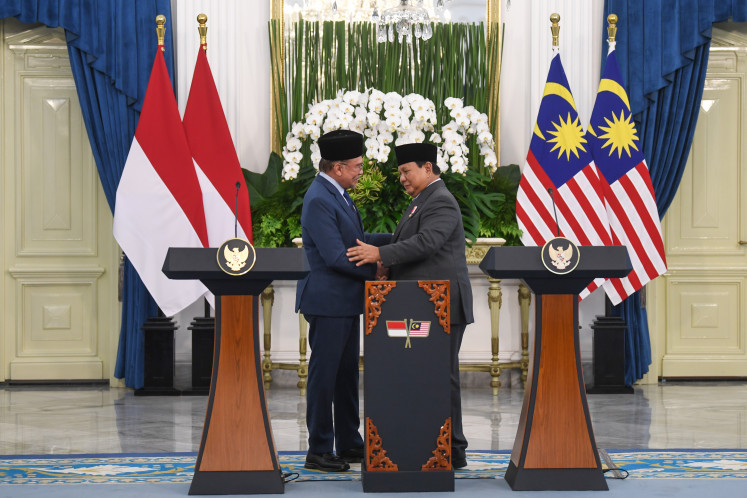Popular Reads
Top Results
Can't find what you're looking for?
View all search resultsPopular Reads
Top Results
Can't find what you're looking for?
View all search resultsLebaran a cultural self-portrait of Indonesia
Many would think that religion is all about doctrine or what people believe is prescribed
Change text size
Gift Premium Articles
to Anyone

M
any would think that religion is all about doctrine or what people believe is prescribed. While doctrine is an important part of everyday life, religion is more about what people practice, what can be described.
Not only is there a huge discrepancy between what is prescribed and what can be described, the gap itself is also filled with dialectical processes of all sort of things. Nevertheless, this is exactly what makes social location and role of religion always interesting. In this regard, the annual festival of Lebaran or Idul Fitri in Indonesia is an illuminating example.
Lebaran, which literally means the aftermath, records and reflect many aspects of the life of Indonesian people, especially Muslims as the majority. It can be seen as a cultural self-portrait that tells a lot about Indonesian reality, then and now.
At least since colonial time, Indonesian Muslims celebrate Lebaran among other things as an expression of identity. While Muslim theologians interpret Idul Fitri as spiritual rebirth or return to purity, both nominal and committed Indonesian Muslims in general practice Lebaran as annual moment for family and social gathering where the presence of their collective identity is strongly visible.
Why do so many people want to take a huge risk and spend a lot of money traveling hundreds of kilometers, sometime for days, crammed in public transportation or riding on motorbikes with their family in annual mass exodus like what is happening these days? Amid this hard and uncertain life for many, being with the family back in one's hometown has extremely powerful meaning for most Indonesians.
Annually this is a brief but empowering moment when people recharge their sense of identity as an individual and a member of community. During Lebaran, migrants feel the profound meaning of this tradition. Not surprisingly, as noted by Harry A. Poeze (1986) who wrote on the Indonesians who lived in the Netherlands in 1600-1950, Lebaran was always the favorite event held by Roepi, an Indonesian student association in the 1930s.
Throughout the Indonesian history, sometimes Lebaran is also very closely related to politics.
In 1929, the Java Bode newspaper wrote that for the first time the Jakartan Muslims held an outdoor Idul Fitri prayer in Gambir Square (Koningsplein). In the 1930s, the world was hit hard by the Great Depression. Many big industries in the Dutch Indies went bankrupt, while political situation in the area was highly uncertain under the shadow of Fascist group's possible invasion. In that critical situation, Lebaran was used by Indonesian political groups to shape public opinion against the colonial government, especially to promote the idea of Indonesian independence.
Writing on the Japanese occupation period, Harry J. Benda (1958) also recorded a very interesting quarrel between the Japanese ruler and the Jakartan Muslims. The Japanese ordered the Muslims to perform Idul Fitri prayer in Gambir Square a few hours earlier than the schedule since the Japanese also wanted to use the same place for sekerai (sun worshiping ritual) before sunrise. Certainly, the Muslims rejected. Lebaran then became an instrument to raise the spirit of Indonesian nationalism against the Japanese imperialism.
In 1946 when the capital city was temporarily moved from Jakarta to Yogyakarta and there was strong disagreement among the nationalist, communist and Muslim leaders over what to do after the Independence, Sukarno used Lebaran as an opportunity for national reconciliation. At different times, however, the holiday was also used for public provocation. In 1962, the national politics was burning due to economic crisis and Sukarno's increasing authoritarianism. To make things worse, Nahdlatul Ulama (NU) and Muhammadiyah celebrated Idul Fitri on two different days. After the Idul Fitri prayer, Sukarno delivered his speech on the political necessity for the Indonesians to reclaim West Papua from the Dutch. In 1964 when Indonesia was in confrontation with Malaysia, Sukarno also used Lebaran occasion to stir public support for his 'crush Malaysia' campaign.
In what is prescribed, Lebaran is supposed to be a moment of mutual forgiveness. In reality, things can be exactly the opposite. We all know that besides communism, political Islam was perceived as the main threat during the New Order's first two decades. David Jenkins (1984) noted that before the 1977 election, Soeharto invited Christian leaders in a closed meeting and said 'Our common enemy is Islam'. On Lebaran occasion in the early 1970s, when Soeharto was just appointed president, M. Natsir and several other ex-Masyumi leaders came to visit the new president in his house. Soeharto just shook their hands and left after telling his guests to sit. Natsir gave up visiting Soeharto after the latter did the same thing during Lebaran for the third time in many years.
It is still fresh in our memory that right on Lebaran of 1999 a sudden sectarian clash broke out between Muslims and Christians in Ambon, claiming thousands of lives and displacing hundreds of others (Jacques Bertrand, 2004).
Although Idul Fitri is also theologically understood as the day of moral victory, only few really pay attention to the poor condition of the Ahmadis and Shiite groups in their refugee camps today. Instead of creating a real reconciliation, Minister of Religious Affairs Suryadharma Ali recently even recommended conversion into mainstream Sunni Islam for the Madurese Shiite to end the conflict. What kind of morality is victorious this holiday for such persecuted religious group as the Sampang Shiite?
Lebaran is also a reflection of social life and how it is being organized. Human exodus that marks Idul Fitri tells us how the national economy is being managed, who the winners and the losers in the game are, how and why everything is highly concentrated in Jakarta, how consumerism is growing out of control in our society and how the government is just submissive to what the big businesses and the free market dictate. It also presents how poor our public transportation and road infrastructure system are, how reckless and dangerous our traffic behavior is, etc.
Of course, politicians are now putting up their images and banners alongside the roads and offering all kinds of 'humanitarian assistance' for tens of millions of exodus travelers. However, who is really working to make systematic real improvement beyond ad-hoc program that lasts only a few weeks? Last year, almost a thousand lives were killed in traffic accidents only within two weeks during the peak season of Lebaran exodus. Who did take it seriously and is seriously working to reduce the Lebaran exodus death toll this year?
As a cultural practice, Lebaran is our self-portrait. Beyond the cosmetic manipulation, indeed it tells us whether we are healthy and have pride as a people. We are supposed to look at it with dignity, to regain self-assurance and recreate hope.
In this regards, the relevant question is not (only) whether we are religiously better people after Lebaran. Instead, whether the holiday tells us that we are moving forward as a people in creating a more peaceful and liberating society based on the principles of equality and justice for all.
The writer is a lecturer at Center for Religious and Cross-Cultural Studies (CRCS), Graduate Program, Gadjah Mada University, Yogyakarta.









